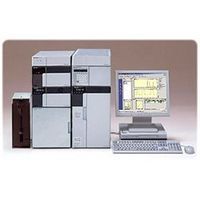Shimadzu - Gel Permeation Chromatography System
Gel permeation chromatography (GPC) is essential in polymer chemistry for measuring the distribution of molecular weights.
designed specifically to provide superior data reliability and ease of use.
Active Questions & AnswersAsk a Question
There are no current Discussions
GPC Gel Permeation Chromatography Service ProvidersView All (17)
Documents & ManualsView All Documents
Features of Gel Permeation Chromatography System
Outstanding Baseline Stability Differential refractive index detectors used in GPC can occasionally react to changes in mobile phase temperature or to the quantity of dissolved air, resulting in baseline instability. However, the Prominence GPC system’s RID-10A detector suppresses baseline drift by locating the optical system inside a double temperature-controlled housing and controlling inflowing mobile phase temperature. Furthermore, the use of a high-efficiency degasser with a capacity of only 380 uL significantly reduces the time required for the system to stabilize.
Solvent Delivery Performance Designed for Repeatability GPC systems measure molecular weight distribution by pseudo-correlating the molecular weights of compounds eluted between the exclusion limit and permeation limit as an exponential function of elution times. As a result, even small elution time errors can lead to large variations in measurement results. To solve this problem, Shimadzu’s Prominence GPC system utilizes high speed micro-plunger actuation and automatic pulse compensation to provide pulse-free solvent delivery and improve elution time repeatability.
Designed for Validation To ensure the reliability of data, equipment maintenance and management are also important. This system's auto-validation feature is useful for IQ/OQ procedures during installation, and for evaluating the operating status of each unit and managing maintenance information during periodic inspections. An optional column management device (CMD) allows the recognition of column name, serial number or other column information, as well as the storage of usage history information, including mobile phase flow rates and the number of sample injections. (When multiple columns are connected, the data’s history can be recorded for a set of columns.)
Easily Creates GPC Calibration Curves using a Visual Interface Use a wide range of approximation formulae to create calibration curves, such as linear, 3rd-order, 3rd-order + hyperbolic curve, 5th-order, 5th-order + hyperbolic curve, 7th-order, 7th-order + hyperbolic curve, or broken line. This software provides up to 64 data points and allows entry of virtual points , so calibration curves can be checked visually for appropriateness while they are being created. Mark-Houwink calibration curve correction methods or various correction methods based on Q-factors or degree of polymerization are also available.
General Specifications
There are no General Specifications available.
Additional Specifications
System Configuration: Modular
Measurement Method: Single Flow
Mobile Phase Delivery Method: Parallel Double Plunger
Mobile Phase Flow Rate Setting Range: 0.0001 mL /min - 10.0000 mL /min
Mobile Phase Flow Rate Accuracy: ± 1% or ± 0.5ΜL/min. (whichever is greater)
Mobile Phase Flow Rate Precision: 0.3 % (0.1 % RSD)
Degassing Method Vacuum Membrane
Degassing Line Flow Rate: 380ΜL
Sample Injection Method: Variable Loop Weighing
Sample Injection Volume Setting Range: 1ΜL to 50ΜL (standard)
Number of Samples Processed: 100 (1.5-mL vials) or 80 (4-mL vials)
Column Temperature Control Method: Forced Air Circulation
Column Temperature Control Range: (Amb. + 10)°C to 85°C
Detector Noise: 2.5 x 10-9 RIU (max.)
Detector Drift: 1.7 x 10-7 RIU/h (max.)
Detector Cell Volume:9ΜL
Detector Cell Temperature Control Range: 30°C - 60°C
Calibration Curve Approximation Formulae: Linear, 3rd-order, 3rd-order + hyperbolic curve, 5th-order, 5th-order + hyperbolic curve, 7th-order, 7th-order +
hyperbolic curve, or broken line
Calibration Curve Correction Functions: Internal Standard Correction, Q-Factor, RID Sensitivity Correction
Peak Integration: Automatic processing according to parameter settings. (Manipulation possible)
Molecular Weight Calculations: Mn, Mw, Mz, Mz1, Mv, Mw/Mn, Mv/Mn, Mz/Mw, and intrinsic viscosity
Data Output: ASCII Format
Data Control: Centralized control via database

